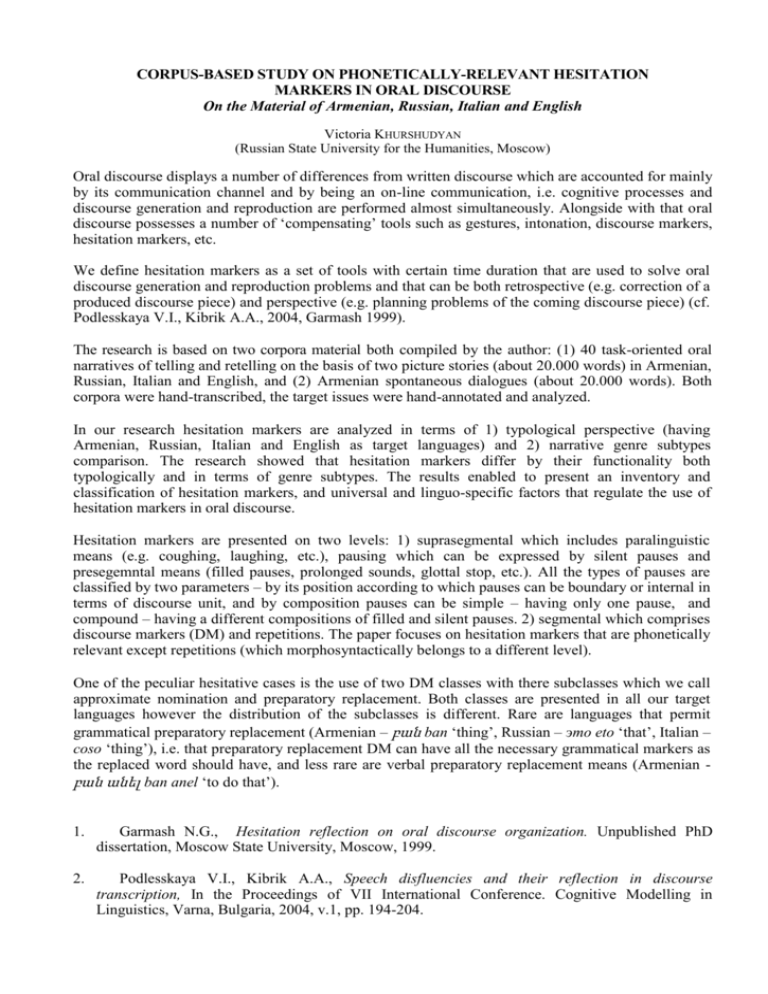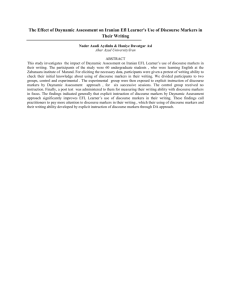ORAL DISCOURSE ANALYSIS: HESITATION MARKERS
advertisement

CORPUS-BASED STUDY ON PHONETICALLY-RELEVANT HESITATION MARKERS IN ORAL DISCOURSE On the Material of Armenian, Russian, Italian and English Victoria KHURSHUDYAN (Russian State University for the Humanities, Moscow) Oral discourse displays a number of differences from written discourse which are accounted for mainly by its communication channel and by being an on-line communication, i.e. cognitive processes and discourse generation and reproduction are performed almost simultaneously. Alongside with that oral discourse possesses a number of ‘compensating’ tools such as gestures, intonation, discourse markers, hesitation markers, etc. We define hesitation markers as a set of tools with certain time duration that are used to solve oral discourse generation and reproduction problems and that can be both retrospective (e.g. correction of a produced discourse piece) and perspective (e.g. planning problems of the coming discourse piece) (cf. Podlesskaya V.I., Kibrik A.A., 2004, Garmash 1999). The research is based on two corpora material both compiled by the author: (1) 40 task-oriented oral narratives of telling and retelling on the basis of two picture stories (about 20.000 words) in Armenian, Russian, Italian and English, and (2) Armenian spontaneous dialogues (about 20.000 words). Both corpora were hand-transcribed, the target issues were hand-annotated and analyzed. In our research hesitation markers are analyzed in terms of 1) typological perspective (having Armenian, Russian, Italian and English as target languages) and 2) narrative genre subtypes comparison. The research showed that hesitation markers differ by their functionality both typologically and in terms of genre subtypes. The results enabled to present an inventory and classification of hesitation markers, and universal and linguo-specific factors that regulate the use of hesitation markers in oral discourse. Hesitation markers are presented on two levels: 1) suprasegmental which includes paralinguistic means (e.g. coughing, laughing, etc.), pausing which can be expressed by silent pauses and presegemntal means (filled pauses, prolonged sounds, glottal stop, etc.). All the types of pauses are classified by two parameters – by its position according to which pauses can be boundary or internal in terms of discourse unit, and by composition pauses can be simple – having only one pause, and compound – having a different compositions of filled and silent pauses. 2) segmental which comprises discourse markers (DM) and repetitions. The paper focuses on hesitation markers that are phonetically relevant except repetitions (which morphosyntactically belongs to a different level). One of the peculiar hesitative cases is the use of two DM classes with there subclasses which we call approximate nomination and preparatory replacement. Both classes are presented in all our target languages however the distribution of the subclasses is different. Rare are languages that permit grammatical preparatory replacement (Armenian – բան ban ‘thing’, Russian – это eto ‘that’, Italian – coso ‘thing’), i.e. that preparatory replacement DM can have all the necessary grammatical markers as the replaced word should have, and less rare are verbal preparatory replacement means (Armenian բան անել ban anel ‘to do that’). 1. Garmash N.G., Hesitation reflection on oral discourse organization. Unpublished PhD dissertation, Moscow State University, Moscow, 1999. 2. Podlesskaya V.I., Kibrik A.A., Speech disfluencies and their reflection in discourse transcription, In the Proceedings of VII International Conference. Cognitive Modelling in Linguistics, Varna, Bulgaria, 2004, v.1, pp. 194-204.






